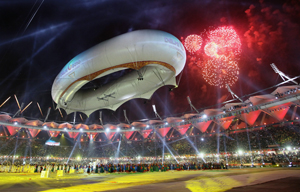There is a proverb that says, “It doesn’t matter how fast you are running if you are going in the wrong direction.” Flipping that statement, even if you are on the right path, speed and efficiency is not guaranteed. For those with a connection to the sports marketplace in India, that may describe your journey to date.
 |
| Sarbit "Sab" Singh |
In the last year, India has had a pretty enviable run, at least on paper, with respect to sports victories.
• IMG has begun executing on its groundbreaking joint venture with Reliance Industries, both via its academies and the purchase of commercial rights to basketball and soccer in the country.
• The Commonwealth Games invited 7,000 athletes from 71 countries to New Delhi in October.
• The just-finished 2011 Cricket World Cup had viewership estimated at more than 1 billion fans fixated with each wicket felled and century scored.
• The NBA further committed itself by undertaking additional grassroots and broadcast initiatives, including its partnership with the Mahindra Group.
• Individual athlete and team performances, including Arjun Atwal becoming the first Indian to win on the PGA Tour.
• Indian national Venkatesh Rao bought the English Premier League’s Blackburn Rovers, giving India’s corporate community another flag to plant, this time in sports, on the world stage.
But the run was not done on such a smooth road. Frankly, more than a few hurdles affected the type of operational and financial performance we would have hoped for, even with a young sporting nation. Unfortunately, India was gripped by some old problems such as corruption, bureaucracy and poor infrastructure.
The IPL, and its first commissioner, Lalit Modi, have been subject to investigations surrounding government interference and corruption in the buying and selling of cricket franchises. In addition, there are issues with ownership of the broadcast rights to the lucrative league. This comes after the second season of the IPL was moved to South Africa — imagine moving the NFL to Canada — due to security concerns in the home country.
| 
GETTY IMAGES
Among India’s recent sports highlights was hosting The Commonwealth Games in October. |
In the fall of 2010, India was strongly criticized for its extremely poor handling of the planning and execution of the Commonwealth Games, leading to poor attendance and soft revenue numbers. And even the Cricket World Cup was subject to alterations due to the lack of readiness of multiple facilities.
Are these “old school” problems significant enough to sidetrack India’s progress, on and off the field? Not likely. And that is because the four pillars holding up this emerging sports market are strong enough to withstand those problems.
1. Two-pronged economic attack: India’s growing middle class and uber-wealthy class (the number of billionaires has grown to total more than 55, according to the latest Forbes list), give it current consumers and funding sources;
2. Its increasingly influential corporate sector, whose prominence both gives U.S. companies partners to work with, and also sway with those in government who may be impeding economic progress;
3. India’s huge population, including its large percentage of young people, who are not only seen as a potentially lucrative consumer base, but the source of a new mind-set that strips away at least some of the layers of bureaucracy and corruption seen in the old India.
4. Outside interest, i.e., companies and organizations from around the world that care about the Indian market. That outside interest draws in money and, just as important, expertise in planning and execution that may help elevate the market above those aforementioned hurdles.
Issues plaguing India are also present with the other so-called BRIC countries: Brazil, Russia and China. In each country, the threats from corruption, bureaucracy and still developing institutions and infrastructure can weaken that fourth pillar. However, each country is combating those challenges with its respective core strengths. And, like the others, the sports business market’s confidence in India is being affirmed by the biggest and most influential sports properties in the world, who are awarding the country mega-events, deals and opportunities.
While it may not be paved and requires some careful navigation, the last year has given ample evidence that the path to the Indian sports marketplace is the right one to take.�0;0;0;8;n
Sarbjit “Sab” Singh (sarbjit.singh@farmingdale.edu) is an assistant professor at Farmingdale State College.





